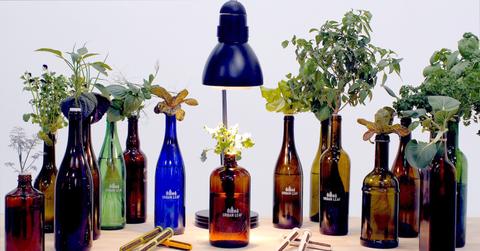‘World’s Smallest Garden’ Allows You To Grow Fresh Vegetables In Upcycled Bottles
The self-described "World's Smallest Garden" utilizes upcycled glass bottles and canisters of seeds to give you a variety of self-watering herbs and greens all year round with absolutely zero effort, no pests, and no weeding required.
Updated May 17 2019, 1:01 p.m. ET
Chances are, if you’re not growing your own food, it’s for one of two reasons: You don’t have the time, or you don’t have the space. Or, for a lot of us, these factors are both obstacles.
It’s absolutely true that many gardens do take up space and time—both of which seem to be on a permanent decline for many people in today’s busy, crowded world. But with the advent of aquaculture, hydroponics, and vertical, mulch, community and permaculture gardens, it’s getting trickier and trickier to come up with reasons why any of us shouldn’t at least be growing some of our own food.
Well, even our last two reasons for not gardening have been kicked to the curb with the advent of the World’s Smallest Garden. The self-watering garden from Urban Leaf utilizes upcycled glass bottles and canisters of seeds to give you a variety of herbs and greens year-round with zero effort.
Whether you’re a lettuce lover, buddy of bok choy, basil baby, or cheerer of cherry tomatoes, Urban Leaf has got your covered. Just grab one of your empty wine bottles, fill it with water, and put in the World’s Smallest Garden—a biodegradable, plastic container with soil and seeds that you simply plug into your bottle like a cork, park the bottle in front of a grow light or sunny window, and let ‘er rip.
And consider this: Every meal for the average American travels more than 1,500 miles to get from farm to table. “We're aiming for 15 feet,” Urban Leaf’s Kickstarter page proclaims. “We're saving food-miles.” Also, consider the average American creates 1,500 pounds of (mostly packaging) waste every year. “We're aiming for zero food-packaging,” the page explains.
And lastly, consider that our American food system lands 40 percent of all food in the garbage each year—the equivalent of $121 billion, and an enormous waste of natural resources. Growing your own food at home brings food waste down to zero percent.
So yes, it’s great for the environment. But what about the flavor of our food?
“Having fresh ingredients, not just herbs, is like the difference between black-and-white and color,” co-founder Nate Littlewood tells Green Matters. “You can make out the form and structure either way, but the vibrancy of fresh ingredients adds an extra dimension to your cooking.”
Littlewood should know—he’s an avid chef, who’s taken cooking courses all over the world, including at the Culinary Arts in Toronto. “My first ever-career aspiration was to become a chef. I told my mom this at the age of 10… A few years later in high school, I remember doing a career questionnaire. We answered about 100 questions on likes and things we were interested in, and a few weeks later got a report back with suggestions about what we might like to do as adults. My number one suggestion was landscape architect.”
Instead, Littlewood got into finance, an industry he left in 2015. “It's taken me about 20 years to get here,” he tells Green Matters, “and I've done a whole lot of other random stuff in between. But I am happy to have come full circle and finally be doing something (professionally) that involves food and gardening. I've been a small-scale gardener for a long time, but it wasn't until I moved to New York that I really learned about hydroponics."
“My mum has a pretty big vegetable garden at home,” Littlewood adds, “perhaps I got it from her!”
Part of the magic of the World’s Smallest Garden is its “smart soil,” which uses a capillary action to draw water up from the bottle and directly into the seed, which eventually sends sprouts into the bottle for continuous watering. For the first month, you won’t need to refill the bottle at all. After that, you’ll just need to top the bottle off. Easy peasy.
The campaign for the World’s Smallest Garden is on Kickstarter until June 21, and has already raised more than $21,000 of its $40,000 goal. Supporting the project with $15 will score you three planter packs for your own World’s Smallest Garden setup, putting you about a month away from your own fresh herbs and greens.
